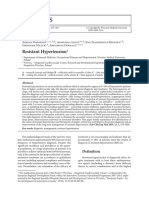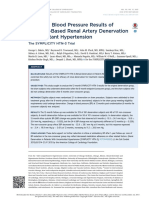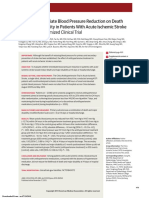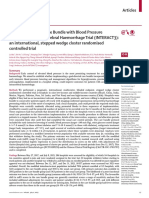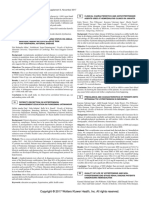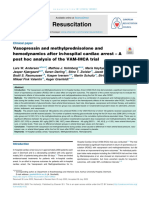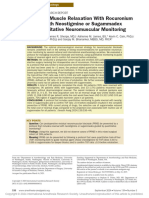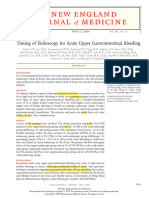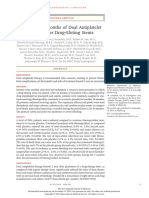On Med
On Med
Uploaded by
Shimily LiangCopyright:
Available Formats
On Med
On Med
Uploaded by
Shimily LiangOriginal Title
Copyright
Available Formats
Share this document
Did you find this document useful?
Is this content inappropriate?
Copyright:
Available Formats
On Med
On Med
Uploaded by
Shimily LiangCopyright:
Available Formats
Articles
Long-term efficacy and safety of renal denervation in the
presence of antihypertensive drugs (SPYRAL HTN-ON MED):
a randomised, sham-controlled trial
Felix Mahfoud, David E Kandzari, Kazuomi Kario, Raymond R Townsend, Michael A Weber, Roland E Schmieder, Konstantinos Tsioufis,
Stuart Pocock, Kyriakos Dimitriadis, James W Choi, Cara East, Richard D’Souza, Andrew S P Sharp, Sebastian Ewen, Antony Walton, Ingrid Hopper,
Sandeep Brar, Pamela McKenna, Martin Fahy, Michael Böhm
Summary
Background Renal denervation has been shown to lower blood pressure in the presence of antihypertensive Lancet 2022; 399: 1401–10
medications; however, long-term safety and efficacy data from randomised trials of renal denervation are lacking. In Published Online
this pre-specified analysis of the SPYRAL HTN-ON MED study, we compared changes in blood pressure, April 4, 2022
https://doi.org/10.1016/
antihypertensive drug use, and safety up to 36 months in renal denervation versus a sham control group.
S0140-6736(22)00455-X
See Comment page 1363
Methods This randomised, single-blind, sham-controlled trial enrolled patients from 25 clinical centres in the USA,
Universitätsklinikum des
Germany, Japan, the UK, Australia, Austria, and Greece, with uncontrolled hypertension and office systolic blood Saarlandes, Saarland
pressure between 150 mm Hg and 180 mm Hg and diastolic blood pressure of 90 mm Hg or higher. Eligible patients University, Homburg, Germany
had to have 24-h ambulatory systolic blood pressure between 140 mm Hg and less than 170 mm Hg, while taking one (Prof F Mahfoud MD,
to three antihypertensive drugs with stable doses for at least 6 weeks. Patients underwent renal angiography and were S Ewen MD, Prof M Böhm MD);
Piedmont Heart Institute,
randomly assigned (1:1) to radiofrequency renal denervation or a sham control procedure. Patients and physicians Atlanta, GA, USA
were unmasked after 12-month follow-up and sham control patients could cross over after 12-month follow-up (D E Kandzari MD); Department
completion. The primary endpoint was the treatment difference in mean 24-h systolic blood pressure at 6 months of Cardiovascular Medicine,
Jichi Medical University School
between the renal denervation group and the sham control group. Statistical analyses were done on the intention-to-
of Medicine, Tochigi, Japan
treat population. Long-term efficacy was assessed using ambulatory and office blood pressure measurements up to (Prof K Kario MD); Perelman
36 months. Drug surveillance was used to assess medication use. Safety events were assessed up to 36 months. This School of Medicine,
trial is registered with ClinicalTrials.gov, NCT02439775; prospectively, an additional 260 patients are currently being University of Pennsylvania,
Philadelphia, PA, USA
randomly assigned as part of the SPYRAL HTN-ON MED Expansion trial.
(Prof R R Townsend MD);
Department of Medicine,
Findings Between July 22, 2015, and June 14, 2017, among 467 enrolled patients, 80 patients fulfilled the qualifying SUNY Downstate College of
criteria and were randomly assigned to undergo renal denervation (n=38) or a sham control procedure (n=42). Mean Medicine, New York, NY, USA
(Prof M A Weber MD);
ambulatory systolic and diastolic blood pressure were significantly reduced from baseline in the renal denervation group,
University Hospital Erlangen,
and were significantly lower than the sham control group at 24 and 36 months, despite a similar treatment intensity of Erlangen, Germany
antihypertensive drugs. The medication burden at 36 months was 2·13 medications (SD 1·15) in the renal denervation (Prof R E Schmieder MD);
group and 2·55 medications (2·19) in the sham control group (p=0·26). 24 (77%) of 31 patients in the renal denervation National and Kapodistrian
University of Athens,
group and 25 (93%) of 27 patients in the sham control group adhered to medication at 36 months. At 36 months, the
Hippocratio Hospital,
ambulatory systolic blood pressure reduction was –18·7 mm Hg (SD 12·4) for the renal denervation group (n=30) and Athens, Greece (K Tsioufis MD,
–8·6 mm Hg (14·6) for the sham control group (n=32; adjusted treatment difference –10·0 mm Hg, 95% CI –16·6 to –3·3; K Dimitriadis MD); London
p=0·0039). Treatment differences between the renal denervation group and sham control group at 36 months were School of Hygiene & Tropical
Medicine, London, UK
–5·9 mm Hg (95% CI –10·1 to –1·8; p=0·0055) for mean ambulatory diastolic blood pressure, –11·0 mm Hg (S Pocock PhD); Baylor Research
(–19·8 to –2·1; p=0·016) for morning systolic blood pressure, and –11·8 mm Hg (–19·0 to –4·7; p=0·0017) for night-time Institute, Jack and Jane
systolic blood pressure. There were no short-term or long-term safety issues associated with renal denervation. Hamilton Heart and Vascular
Hospital, Dallas, TX, USA
(J W Choi MD, C East MD);
Interpretation Radiofrequency renal denervation compared with sham control produced a clinically meaningful and The Royal Devon and Exeter
lasting blood pressure reduction up to 36 months of follow-up, independent of concomitant antihypertensive Hospital, Exeter, UK
medications and without major safety events. Renal denervation could provide an adjunctive treatment modality in (R D’Souza MD); University
the management of patients with hypertension. Hospital of Wales, Cardiff, UK
(A S P Sharp MD); The Alfred
Hospital, Melbourne, VIC,
Funding Medtronic. Australia (A Walton MD,
I Hopper PhD); Medtronic,
Copyright © 2022 Elsevier Ltd. All rights reserved. Santa Rosa, CA, USA (S Brar MD,
P McKenna BS, M Fahy MS)
Introduction Poor adherence to pharmacological treatments is
Hypertension is the leading cause of death worldwide,1 frequently observed in hypertension management and
and a reduction in blood pressure has been shown to highlights the need for additional treatment options.6
lower the risk of cardiovascular events and mortality.2–5 Randomised sham-controlled trials have shown the safety
www.thelancet.com Vol 399 April 9, 2022 1401
Articles
Correspondence to:
Prof Felix Mahfoud, Klinik für
Research in context
Innere Medizin III, Kardiologie,
Evidence before this study antihypertensive medications. The reduction in ambulatory
Angiologie und Internistische
Intensivmedizin, We searched PubMed using the terms “renal denervation”, blood pressure following renal denervation was progressive
66421 Homburg, Germany “hypertension”, and “clinical trial” for papers published in English throughout follow-up.
felix.mahfoud@uks.eu between Jan 1, 2018, and Jan 31, 2022. The search returned
Implications of all the available evidence
39 clinical trial reports of renal denervation for treatment of
Significant reductions in night-time and early morning
hypertension, as well as 24 review papers, 11 meta-analyses,
ambulatory blood pressure at 24 months and 36 months could
five design papers, and two position papers or consensus. Adding
translate into reductions in cardiovascular events, including
the search term “medication adherence” resulted in identification
stroke and heart failure. The sustained nature of 24-h blood
of four clinical trials and three review articles.
pressure reduction with renal denervation might be
Added value of this study superior to treatments with antihypertensive drugs, which are
This trial investigated the long-term safety and efficacy of often associated with non-adherence. The data support the
catheter-based renal denervation in patients with uncontrolled favourable long-term safety profile of catheter-based renal
hypertension who were taking one to three antihypertensive denervation. Renal denervation provides an adjunctive
drugs. The procedure was safe and associated with significant treatment modality besides lifestyle modifications and
and consistent clinically meaningful long-term reductions in antihypertensive medications in the management of patients
ambulatory blood pressure compared with a sham control with uncontrolled hypertension.
procedure, with no differences in the number of
and efficacy of catheter-based renal denervation to lower and Greece. Patients were eligible if they had office
blood pressure in the presence7,8 and absence9–11 of systolic blood pressure of at least 150 mm Hg but less
antihypertensive medications. Since randomised trial than 180 mm Hg, office diastolic blood pressure of at
primary endpoints are limited to short follow-up, whether least 90 mm Hg, mean 24-h systolic blood pressure of at
reductions in blood pressure following renal denervation least 140 mm Hg but less than 170 mm Hg, and were
are durable or further decreased over long-term follow-up taking one to three antihypertensive medications. Full
is unclear. Non-randomised catheter-based renal inclusion and exclusion criteria are provided in the
See Online for appendix denervation studies have shown sustained reductions in appendix (pp 2–5).
blood pressure for up to 3 years;12–15 however, data from The trial protocol was approved by each participating
randomised sham-controlled trials on long-term safety local ethics committee or institutional review board, and
and efficacy are lacking and challenging to obtain because all patients provided written informed consent to
of variance in medications, influence of unblinding status participate. The trial was designed in accordance with the
among patients and health-care providers, and control Declaration of Helsinki.
group crossover to renal denervation.16 The SPYRAL
HTN-ON MED trial was initially designed as a proof-of- Randomisation and masking
concept study with non-powered endpoints to minimise Patients were randomly assigned (1:1) to renal
exposure of patients to an interventional procedure. We denervation or sham control. Randomisation was
previously reported a favourable safety and efficacy profile stratified by trial centre, using block randomisation with
in these patients at 6 months7 and this report represents a block size of four. SAS-based software was used to
long-term safety and efficacy results. In this pre-specified generate the lists of randomisation codes and participants
For more on ICON see analysis of the SPYRAL HTN-ON MED study,17 we were assigned to their intervention by ICON via the
https://www.iconplc.com compared changes in blood pressure, antihypertensive website. Patients and designated trial staff conducting
drug use, and safety up to 36 months in renal denervation follow-up assessments were masked to study group
versus a sham control group. assignment up to 12 months after randomisation.
Methods Procedures
Study design and participants For patients undergoing the renal denervation
The SPYRAL HTN-ON MED proof-of-concept trial was a procedure, the four-electrode Symplicity Spyral catheter
single-blind, sham-controlled, randomised trial of (Medtronic; Galway, Ireland) and the Symplicity G3
80 patients. The trial has previously been described in radio frequency generator (Medtronic; Minneapolis,
detail and 6-month outcomes reported.7,17 Prospectively, an MN, USA) were used to provide radiofrequency ablations
additional 260 patients are currently being randomly in a spiral pattern in renal arteries and branch vessels
assigned as part of the SPYRAL HTN-ON MED Expansion between 3 and 8 mm in diameter. One interventionalist
trial. from each centre performed the renal denervation
Briefly, patients were enrolled from 25 clinical centres procedure to minimise inter-operator variability. Patients
in the USA, Germany, Japan, the UK, Australia, Austria, who received the sham procedure remained on the
1402 www.thelancet.com Vol 399 April 9, 2022
Articles
procedure table for at least 20 min during the renal medications were used to determine antihypertensive
angiogram to help prevent possible unmasking of medication burden.
randomisation. Blood tests for sodium, potassium, glucose, and serum
At all visits, patients were required to take prescribed creatinine were done at each follow-up visit. The estimated
antihypertensive medications in the presence of staff glomerular filtration rate (eGFR) was calculated using the
members before initiating 24-h ambulatory blood four variable modification of diet in renal disease formula18
pressure monitoring. The protocol allowed changes in or the local Japanese criteria for patients enrolled in Japan.19
anti
hypertensive medications after 6 months at the At 3, 6, 12, 24, and 36 months, ambulatory blood pressure
discretion of the treating physician. Prescription of (Mobil-O-Graph; IEM; Stolberg, Germany) and office
antihypertensive medication dose and class was according blood pressure were measured as outlined in the appendix
to the treating physician. A list of prescribed anti (pp 9–10). For patients in the sham control group, the
hypertensive medications was collected at all in-person study was originally designed to only collect safety
and telephone follow-up visits. The study was originally outcomes at 24 months and 36 months. Subsequently, the
designed to only collect urine and blood tests to assess study protocol was updated to include in-person blood
antihypertensive medication use for up to 6 months. pressure assessment for patients in the sham control
Subsequently, the study protocol was updated to also group at 24 months and 36 months; however, not all
include medication use assessment at 24 months and patients consented before 24 months, resulting in some
36 months. All available drug testing data and prescribed missed blood pressure measurements at 24 months.
Duplex ultrasound, CT, or MRI was recommended to
Renal denervation Sham procedure be done either at 12, 24, or 36 months to assess renal
group (n=38) group (n=42) artery anatomy.
Age, years 53·9 (8·7) 53·0 (10·7) The protocol states that patients in the sham control
Sex group are eligible for crossover to receive renal denervation
Female 5 (13%) 8 (19%) after their 12-month follow-up visit according to patient
Male 33 (87%) 34 (81%) and investigator discretion; there was no required blood
Body-mass index, kg/m² 31·4 (6·4) 32·5 (4·6) pressure range to qualify for crossover. However, approval
Race for crossovers in the study did not occur until after
White 13 (34%) 15 (36%) outcomes in the renal denervation group were deemed
Black or African American 4 (11%) 5 (12%) positive, as determined by the study sponsor and the
Asian 3 (8%) 2 (5%) Executive Steering Committee, which did not occur until
Not reportable per local laws 18 (47%) 20 (48%) most patients had passed their 24-month visit.
or regulations
Estimated glomerular filtration 81·9 (15·3) 82·0 (20·0) Outcomes
rate (ml/min per 1·73 m²) The primary endpoint was the treatment difference in
Type 2 diabetes 5 (13%) 8 (19%) mean 24-h systolic blood pressure at 6 months between
Current smoker 8 (21%) 11 (26%) the renal denervation group and the sham control group,7
Obstructive sleep apnoea 2 (5%) 10 (24%) and was centrally assessed.
Peripheral artery disease 0 0 A complete list of secondary endpoints is included in
Coronary artery disease 1 (3%) 1 (2%) the appendix (pp 6–8).
Myocardial infarction or acute 0 0 Long-term safety was compared between the renal
coronary syndrome
denervation group and sham control group up to
Stroke 0 1 (2%) 36 months using a composite endpoint of major adverse
Blood pressure, mm Hg events, comprising all-cause mortality, end-stage renal
Office systolic blood pressure 164·4 (7·0) 163·5 (7·5)
Office diastolic blood pressure 99·5 (6·9) 102·7 (8·0) Renal denervation Sham control p value*
Mean 24-h systolic blood 152·1 (7·0) 151·3 (6·8) group group
pressure
Baseline 2·13 (1·40)† 1·98 (1·14)‡ 0·59
Mean 24-h diastolic blood 97·2 (6·9) 97·9 (8·4)
3 months 1·84 (1·37)† 2·05 (1·10)‡ 0·044
pressure
6 months 2·13 (1·40)† 2·21 (1·05)‡ 0·17
Morning systolic blood 156·7 (14·1) 156·6 (16·7)
pressure 12 months 2·53 (0·89)† 2·81 (0·99)‡ 0·09
Daytime systolic blood 156·6 (8·6) 157·3 (8·6) 24 months 2·97 (1·21)§ 2·95 (1·16)¶ 0·74
pressure 36 months 3·03 (1·20)|| 3·05 (1·43)** 0·76
Night-time systolic blood 142·0 (12·9) 139·7 (10·7) Data are mean (SD), unless otherwise indicated. *From ANCOVA. †n=38. ‡n=42.
pressure §n=36. ¶n=41. ||n=35. **n=39.
Data are mean (SD) or n (%).
Table 2: Number of antihypertensive medications from baseline to
Table 1: Baseline characteristics 36 months
www.thelancet.com Vol 399 April 9, 2022 1403
Articles
disease, an embolic event resulting in end-organ and percentages and were compared between treatment
damage, renal artery perforation or dissection requiring groups using exact binomial tests. Continuous variables
intervention, vascular complications, hospitalisation for are reported as mean (SD). Baseline measures were
hypertensive crisis, and new renal artery stenosis greater compared between the renal denervation group and
than 70%. Other safety endpoints collected included sham control group using t tests. Follow-up change
myocardial infarction, stroke, renal artery reintervention, measures were compared between the renal denervation
major bleeding, and an increase in serum creatinine of group and sham control group using ANCOVA,
more than 50% from baseline. For each reported adverse adjusting for baseline measurements. For patients in
event, the investigator assessed the event in terms of the the sham control group who crossed over and received
relationship to the device, procedure, or renal denervation renal denervation between the 24-month and 36-month
therapy (if applicable), and then the Clinical Events follow-up visit, the last observations of blood pressure
Committee independently adjudicated these events. Long- measurements, medication burden, and laboratory
term efficacy was evaluated from baseline to 36 months. values were used to impute their 36-month values.
Antihypertensive medication burden was assessed
Statistical analysis using four medication indices, as described in the
Statistical analyses were done on the intention-to-treat appendix (pp 11–15).
population. Categorical variables are reported as counts A Data Safety Monitoring Board monitored the health,
safety, and welfare of patients enrolled in the study. The
A Executive Steering Committee comprises scientific experts
5 Renal denervation in the fields of cardiology, cardiovascular disease, statistics,
Control
hypertension, and internal medicine, with at least one
Change in 24-h systolic blood pressure (mm Hg)
0
0·3
member affiliated to the study funder. The Executive
–1·6
Steering Committee monitors project status and com
–5 –7·8 pliance, ensures study objectives are being adequately
–4·7
–4·0 addressed, and provides guidance for the overall conduct
–10 p=0·231 –8·6 of the study.
–9·3 SAS for Windows version 9.4 was used for all statistical
–9·7
p=0·0041 –16·0 analyses. The trial is registered with ClinicalTrials.gov,
–15 p=0·553
NCT02439775.
–18·7
–20 p=0·0031
Role of the funding source
p=0·0039 The Executive Steering Committee designed the protocol
–25 and identified clinical sites in collaboration with the funder
B of the study. The funder was responsible for collection,
5 monitoring, and analysis of the data. Interpretation of the
data and writing of the manuscript was the
Change in 24-h diastolic blood pressure (mm Hg)
responsibility of the lead author with contributions from
the Executive Steering Committee and coauthors. The
0
–0·2 funder assisted in figure and table generation, copy
–1·9
editing, and formatting.
–5·9
–5
–3·8 –5·0
Results
p=0·067 –6·0 Between July 22, 2015, and June 14, 2017, among
–6·0
–6·7 467 enrolled patients, 80 patients fulfilled the qualifying
p=0·018 –10·5
–10
p=0·695 criteria and were randomly assigned to undergo renal
–11·9
denervation (n=38) or a sham control procedure (n=42).
p=0·025
The number of patients with available blood pressure
p=0·0055
–15 measurements at each follow-up is shown in the
Baseline 3 months 6 months 12 months 24 months 36 months appendix (p 21). In the sham control group, 13 patients
Time crossed over and received renal denervation between their
n
Renal denervation ·· 35 36 34 33 30 24-month and 36-month visits; therefore, 36-month values
Control ·· 32 36 38 17* 32
for these patients were imputed using the value before the
Figure 1: Change in 24-h systolic blood pressure (A) and diastolic blood pressure (B) from baseline up to crossover renal denervation procedure (p 16). Baseline
36 months characteristics, including blood pressure, were similar
Mean sham control measurements at 36 months include 13 imputed crossover patients’ blood pressure values between patients in the renal denervation group and
from the most recent measurements before the renal denervation procedure. Error bars represent the SE. *Only
safety event follow-up was originally required for patients in the sham control group after 12 months, and not all
patients in the sham control group (table 1). The number
patients reconsented before 24-month follow-up. of antihypertensive medications was similar between the
1404 www.thelancet.com Vol 399 April 9, 2022
Articles
renal denervation group and sham control group at medication at 24 months, and 24 (77%) of 31 patients in
baseline and all follow-up timepoints (table 2). At the renal denervation group and 25 (93%) of 27 patients in
24 months, patients in the renal denervation group were the sham control group adhered to medication at
prescribed a mean of 2·97 antihypertensive medications 36 months.
(SD 1·21), compared with 2·95 antihypertensive Long-term changes in 24-h systolic blood pressure and
medications (1·16) for patients in the sham control group diastolic blood pressure from baseline to 36 months show
(p=0·74). At 36 months, patients in the renal denervation sustained reductions in blood pressure, with increasing
group were prescribed a mean of 3·03 antihypertensive reductions after renal denervation over time (figure 1). At
medications (1·20), compared with 3·05 antihypertensive 36 months, the ambulatory systolic blood pressure
medications (1·43) for participants in the sham control reduction was –18·7 mm Hg (SD 12·4) for the renal
group (p=0·76). However, when also accounting for denervation group (n=30) and –8·6 mm Hg (14·6) for the
medication classes and dosages, comparison of sham control group (n=32; adjusted treatment difference
medication indices at 12 months found a significantly –10·0 mm Hg, 95% CI –16·6 to –3·3; p=0·0039). At
greater antihypertensive medication burden for patients 24 months and 36 months, there were significantly
in the sham control group at 12 months (MEDINDEX2 greater reductions in mean 24-h, morning, daytime, and
and MEDINDEX3; appendix p 17). The medication burden night-time systolic blood pressure for patients in the
at 36 months was 2·13 medications (SD 1·15) in the renal renal denervation group compared with patients in the
denervation group and 2·55 medications (2·19) in the sham control group (figure 2). At 24 months, mean
sham control group (p=0·26; appendix p 17). Nine (82%) treatment differences were –11·2 mm Hg (95% CI
of 11 patients in the renal denervation group and 14 (88%) –21·7 to –0·6; p=0·039) for morning systolic blood
of 16 patients in the sham control group adhered to pressure and –12·9 mm Hg (–21·1 to –4·7; p=0·0026) for
Renal denervation
Control
A
0
–4·7 –0·7
Systolic blood pressure change at
–7·3 –6·2
–7·8
–5
24 months (mm Hg)
–16·0 –17·5 –15·4 –16·5
–10 –19·3
–15
∆ –11·2 mm Hg ∆ –10·2 mm Hg
–20 ∆ –12·9 mm Hg
(95% CI –18·4 to –4·0) ∆ –11·2 mm Hg (95% CI –18·0 to –2·3)
(95% CI –21·1 to –4·7) ∆ –11·1 mm Hg
p=0·0031 (95% CI –21·7 to –0·6) p=0·013
–25 p=0·0026 (95% CI –21·6 to –0·5)
p=0·039
p=0·041
–30
n 33 17 32 17 33 17 33 17 34 17
Baseline blood 152 151 157 157 157 157 142 140 164 164
pressure (mm Hg)
B
0
–6·6
Systolic blood pressure change at
–5 –8·6 –9·7 –10·5
–12·5
36 months (mm Hg)
–10 –18·7 –18·3 –19·3 –20·9
–20·6
–15
–20
∆ –10·0 mm Hg ∆ –8·9 mm Hg
∆ –11·8 mm Hg
(95% CI –16·6 to –3·3) ∆ –11·0 mm Hg (95% CI –16·5 to –1·2) ∆ –8·2 mm Hg
–25 (95% CI –19·0 to –4·7)
p=0·0039 (95% CI –19·8 to –2·1) p=0·024 (95% CI –17·1 to 0·8)
p=0·0017
p=0·016 p=0·073
–30
24-h systolic blood Morning systolic blood Daytime systolic blood Night-time systolic blood Office systolic blood
pressure pressure pressure pressure pressure
n 30 32 30 32 30 32 30 32 33 34
Baseline blood 152 151 157 157 157 157 142 140 164 164
pressure (mm Hg)
Figure 2: Reduction in mean systolic blood pressure at (A) 24 months and (B) 36 months for renal denervation compared with sham control for 24-h,
morning, daytime, night-time, and office systolic blood pressure
Only safety event follow-up was originally required for patients in the sham control group after 12 months, and not all patients reconsented before 24-month
follow-up. 36-month sham control blood pressure measurements include 13 imputed values from crossover patients.
www.thelancet.com Vol 399 April 9, 2022 1405
Articles
A Renal denervation Sham control
Renal denervation at baseline (n=38) Renal denervation at 24 months (n=33) group group
Control at baseline (n=42) Control at 24 months (n=17)
Composite safety endpoint* 1 1
Night-time Morning Daytime All-cause death 0 1†
160
New myocardial infarction 0 0
New stroke 1‡ 0
Systolic blood pressure (mm Hg)
150 Hospitalisation for hypertensive 1‡ 0
crisis or emergency
Major bleeding (TIMI) 0 0
140 End-stage renal disease 0 0
Embolic event resulting in end- 0 0
organ damage
130
Renal artery reintervention 0 0
Renal artery perforation 0 0
requiring reintervention
120
Renal artery dissection requiring 0 0
reintervention
Vascular complication§ 0 0
B
Renal denervation at baseline (n=38) Renal denervation at 36 months (n=30)
New renal artery stenosis >70% 0 0
Control at baseline (n=42) Control at 36 months (n=32) Serum creatinine reduction >50% 0 0
Data show number of patients with events. TIMI=thrombolysis in myocardial
160 infarction. *Defined as a composite of all-cause mortality, end-stage renal disease,
embolic event resulting in end-organ damage, renal artery perforation requiring
reintervention, renal artery dissection requiring reintervention, vascular
Systolic blood pressure (mm Hg)
complications, hospitalisation for hypertensive crisis or emergency, or new renal
150 artery stenosis >70%. †One cardiovascular death occurred 693 days after the
procedure; the patient was found unconscious at home, and an autopsy was not
performed; therefore cause of death is unknown. ‡One patient had a
140 hypertension crisis and stroke at 427 days after the procedure; the patient
presented to the emergency department with weakness on the left side and
elevated blood pressure (193/123 mm Hg), received in-patient treatment, and
was discharged in a stable condition. §Defined as requiring surgical repair,
130 interventional procedure, thrombin injection, or blood transfusion.
Table 3: Safety events at 36 months
120
h h h h h h h h h h h h 24 months for patients in the renal denervation group
00 00 00 00 00 00 00 00 00 00 00 00
00 02 04 06 08 10 12 14 16 18 20 22
compared with patients in the sham control group. Mean
Time
blood pressures in the renal denervation group and sham
Figure 3: Hourly plots comparing 24-h systolic blood pressures at baseline and (A) 24 months and (B) control group at each timepoint are shown in the
36 months post-procedure appendix (p 19). Six (18%) of 33 patients in the renal
Night-time is 0100 h to 0600 h, morning is 0700 h to 0900 h, daytime is 0900 h to 2100 h. Only safety event
denervation group and one (6%) of 17 patients in the
follow-up was originally required for patients in the sham control group after 12 months, and not all patients
reconsented before 24-month follow-up. Mean sham control measurements at 36 months include 13 imputed sham control group had mean 24-h systolic blood
crossover patients’ blood pressure values from their most recent measurements before the renal denervation pressure less than 130 mm Hg and 24-h diastolic blood
procedure. Error bars represent the SE. pressure less than 80 mm Hg at 24 months (p=0·398),
and six (20%) of 30 patients in the renal denervation
night-time systolic blood pressure. At 36 months, group and one (3%) of 32 patients in the sham control
treatment differences were –5·9 mm Hg (95% CI –10·1 group had mean 24-h systolic blood pressure less than
to –1·8; p=0·0055) for mean ambulatory diastolic blood 130 mm Hg and 24-h diastolic blood pressure less than 80
pressure, –11·0 mm Hg (–19·8 to –2·1; p=0·016) for mm Hg at 36 months (p=0·050). 11 (33%) of 33 patients
morning systolic blood pressure and –11·8 mm Hg in the renal denervation group and three (18%) of
(–19·0 to –4·7; p=0·0017) for night-time systolic blood 17 patients in the sham control group had mean 24-h
pressure. Similar results were observed for 24-h diastolic systolic blood pressure less than 130 mm Hg (regardless
blood pressure (appendix p 22). Results from a sensitivity of 24-h diastolic blood pressure measures) at 24 months
analysis for 24 months and 36 months show changes in (p=0·327), and 12 (40%) of 30 patients in the renal
mean 24-h systolic blood pressure without imputation for denervation group and eight (25%) of 22 patients in the
patients who crossed over to renal denervation (appendix sham control group had mean 24-h systolic blood
p 18). Office systolic blood pressure and diastolic blood pressure less than 130 mm Hg (regardless of 24-h
pressure reductions were significantly greater at diastolic blood pressure measures) at 36 months
1406 www.thelancet.com Vol 399 April 9, 2022
Articles
(p=0·279). We found no significant differences in office reduction for the renal denervation group at 6 months,
heart rate between the renal denervation group and the suggesting a progressive effect of renal denervation on
sham control group at 12, 24, and 36 months after random blood pressure reduction.24 The Global SYMPLICITY
assignment. Registry, with more than 3000 patients enrolled, has
Comparison of hourly changes in ambulatory systolic shown progressive reductions in blood pressure after
blood pressure between the renal denervation group renal denervation up to 3 years, without an increase in
and the sham control group at 24 months and 36 months medication burden,15 which is consistent with the data
showed greater reductions across the 24-h period for the presented in this study. This progressive reduction
renal denervation group (figure 3), with similar results could be caused by long-term continued remodelling of
for ambulatory diastolic blood pressure (appendix p 23). the vasculature following modulation of the sympathetic
Safety events were rare during the 36 months of the nervous system by renal denervation, causing changes
study, with one death of unknown cause in the sham in total peripheral resistance and hence pulse wave
control group and one stroke and hypertensive crisis in reflection.25,26 Furthermore, renal denervation alters the
the renal denervation group (table 3). There were no activity of the renin angiotensin aldosterone system.
instances of renal artery stenosis or re-intervention Indeed, in the SPYRAL HTN-OFF MED Pivotal study, a
associated with renal denervation during the 36 months significant reduction in plasma renin activity and
of follow-up. Changes in eGFR, serum creatinine, aldosterone concentration was observed following renal
sodium levels, and potassium levels from baseline denervation compared with sham control treatment.27
to 24 months and 36 months did not differ between the Whether these alterations interfere long term with
renal denervation group and the sham control group antihypertensive medications is unclear, but might
(appendix p 20). explain the progressive decline in blood pressure
observed in this study.
Discussion Concerns have been expressed regarding functional
In this study, long-term results from the SPYRAL HTN- reinnervation of the kidneys and long-term durability of
ON MED trial showed significant reductions in 24-h renal denervation. Preclinical data in hypertensive sheep
systolic blood pressure and diastolic blood pressure at with chronic kidney disease suggest partial regrowth of
24 months and 36 months in patients who underwent renal nerves and return of function 30 months after renal
renal denervation compared with patients who denervation.28 In comparison, a study in pigs showed
underwent a sham control procedure, despite similar permanent axonal destruction and sustained reductions
antihypertensive drug use, with a favourable safety in renal norepinephrine indicative of unrecoverable
profile. Although previous non-randomised studies and sympathetic nerve activity.29 Similarly, the sustained
registries12,13,15 showed increasing reductions in blood reductions in blood pressure observed up to 36 months
pressure after radiofrequency renal denervation at after renal denervation in this study showed no
3 years, this trial enabled comparison of changes in blood significant functional reinnervation in this cohort of
pressure with a sham control group with similar baseline patients with hypertension.
demographics and blood pressure values, showing the Assessment of the durability in blood pressure lowering
long-term efficacy of catheter-based renal denervation. between renal denervation versus sham control
The reported sustained reductions in daytime, night- procedures in randomised trials has been recognised as
time, morning, and mean 24-h blood pressure at challenging. These challenges include potential changes
36 months are relevant because they are associated with in pharmacotherapy, drug adherence, patient lifestyle,
significant reductions in cardiovascular morbidity and and co-existing health conditions.30 It is also difficult to
mortality.20 In particular, treatment differences in keep patients on stable medications long term in sham-
morning systolic blood pressure and night-time systolic controlled clinical trials because of safety concerns related
blood pressure are relevant, since both closely correlate to uncontrolled blood pressure.31,32 In the current study,
with risk of cardiovascular events, such as stroke and changes in antihypertensive medication were allowed
heart failure, highlighting the importance of anti after 6-month follow-up and left at the physician’s
hypertensive treatment strategies that target these time discretion. This allowance resulted in a similar number
periods.21–23 The reductions after renal denervation versus of antihypertensive medications between the renal
sham control for morning and night-time systolic blood denervation group and the sham control group at
pressure in this study might translate into a meaningful 12 months, but a higher medication burden when
risk reduction.21–23 accounting for medication classes and dosages for the
A progressive decline in blood pressure over time sham control group compared with the renal denervation
after renal denervation has been reported in randomised group. This finding could potentially explain the non-
and non-randomised trials. The REDUCE HTN: significant blood pressure treatment differences between
REINFORCE trial found similar reductions in blood the renal denervation group and sham control at
pressure after renal denervation compared with sham 12 months. The sustained nature of 24-h blood pressure
control at 2 months, but a greater blood pressure reduction with renal denervation as observed at 24 months
www.thelancet.com Vol 399 April 9, 2022 1407
Articles
and 36 months might be superior to treatments with not evaluate changes in patients’ exercise, diet, or
antihypertensive drugs with a short half-life or partial and smoking habits, which could have influenced blood
complete non-adherence, including the missing of a pressure measurements. Moreover, there were no
single dose, not providing consistent protection over 24 h specific blood pressure criteria that were required for the
in contrast to the always-on quality of renal denervation.7 purposes of crossover.
The addition of one antihypertensive drug in Follow-up for this trial was conducted during the
combination with renal denervation led to a 20·9 mm Hg COVID-19 pandemic; however, in-person follow-up visits
reduction in office systolic blood pressure at 36 months, were not affected. It is unclear whether COVID-19
suggesting that renal denervation produced a sustained affected patients’ blood pressure and behaviour. We
effect of at least 10 mm Hg.33 Such a reduction is modified case report forms to collect information on
considered clinically meaningful and is thought to be patients’ infection status, and no cases were reported in
associated with lower rates of cardiovascular events. Data this population. There was a lower percentage of women
from meta-analyses reported a 20% reduction in risk of enrolled in this study compared with other studies of
cardiovascular events with a 10-mm Hg reduction in renal denervation, such as the Global SYMPLICITY
systolic blood pressure.2,4 We observed a progressive Registry,15 and future clinical studies should prioritise
decline in blood pressure up to 36 months. However, in equitable enrolment of women. Finally, long-term results
both the renal denervation group and sham control from this trial are specific to radiofrequency renal
group, mean office systolic blood pressure was greater denervation procedures and might not be generalisable
than 140 mm Hg at 36 months despite the ability of to other renal denervation modalities.
physicians to increase antihypertensive medications after In conclusion, in the SPYRAL HTN-ON MED trial,
6 months, suggesting clinician inertia to aggressively radiofrequency renal denervation compared with a sham
titrate medications to reach target of 140 mm Hg, patients’ control procedure produced clinically meaningful blood
difficulty in tolerating increases in medication, or both.34 pressure reductions, independent of concomitant
Similar to the approach outlined for the primary antihypertensive medications, up to 36 months without
analysis at 6 months,7 last observation carried forward safety issues. Given this long-term safety and efficacy
blood pressure measurements were imputed for finding, renal denervation could provide an adjunctive
13 patients in the control group who underwent a treatment modality in the management of patients with
crossover renal denervation procedure between hypertension.
24-month and 36-month follow-up. The outcomes Contributors
observed at 24 months without imputation were similar FM and MB created the first draft of the manuscript. MB, KK, DEK,
to those at 36 months with imputation. Since more FM, MAW, RES, KT, SP, RRT, SB, and PM participated in the design of
the study. FM, MB, KK, DEK, RES, KT, KD, JWC, CE, SE, RD, ASPS,
36-month blood pressure data were missing in the sham AW, and IH participated in patient data collection. MF did the statistical
control group than in the renal denervation group analysis and contributed to the writing of the report. All authors were
because of expected crossover of patients assigned to the involved in interpretation of the data. All authors agreed on the content
sham control, the missing data were not completely of the manuscript, reviewed drafts, and approved the final version.
FM and MB had unrestricted access to all the data in the study and all
random; therefore, imputation was appropriate to authors were responsible for the final decision to submit for
reduce bias.35 publication.
One safety event occurred in each study group Declaration of interests
throughout the 36 months after random assignment. FM is supported by Deutsche Gesellschaft für Kardiologie, Deutsche
There were no instances of renal artery re-intervention or Forschungsgemeinschaft (SFB TRR219), and Deutsche Herzstiftung,
vascular complications after renal denervation. These and has received scientific support and/or speaker honoraria from
AstraZeneca, Bayer, Boehringer Ingelheim, Medtronic, and ReCor
results support the findings of a meta-analysis of Medical. DEK reports institutional research or grant support from
5769 patients, which also found renal artery re- Biotronik, Boston Scientific, Cardiovascular Systems, Orbus Neich,
intervention after radiofrequency renal denervation to be Teleflex, Medtronic, and Ablative Solutions, and personal consulting
rare (pooled annual incidence 0·2%).36 In this population honoraria from Ablative Solutions, Cardiovascular Systems, Magenta
Medical, Medtronic, and Terumo. KK received personal fees from
with hypertension, observed eGFR changes were within Medtronic, during the conduct of the study, grants from Teijin Pharma,
the expected range and did not differ between the renal Omron Healthcare, Fukuda Denshi, Bayer Yakuhin, A&D Pharma,
denervation group and the sham control group.37 Daiichi Sankyo, Mochida Pharmaceutical, EA Pharma, Boehringer
Ingelheim Japan, Tanabe Mitsubishi Pharma Corporation, Novartis
There were several limitations in this study. Blood and
Pharma, Shionogi & Co, Terumo Corporation, MSD, and Sanwa Kagaku
urine testing were done to assess antihypertensive Kenkyusho, and personal fees from Bristol-Myers Squibb, Takeda
medication use at discrete timepoints and do not Pharmaceutical, Daiichi Sankyo, Omron Healthcare, Bayer Yakuhin,
necessarily imply complete adherence or non-adherence Mochida Pharmaceutical, and Sumitomo Dainippon Pharma, outside
the submitted work. RRT is a consultant for Medtronic, Axio, and
over an extended period of time. However, the
Janssen. MAW is a consultant for Medtronic, ReCor Medical, Ablative
combination of drug testing and collection of prescribed Solutions, Johnson & Johnson, and Urovant. RES reports grants and
medications provides a reasonable estimate of patients’ personal fees from Medtronic, ReCor Medical, and Ablative Solutions.
antihypertensive medication burden in the trial. Blood KT receives payments from Medtronic for work as centre principal
investigator. SP reports personal fees from Medtronic, outside the
and urine testing were not required at 12 months. We did
1408 www.thelancet.com Vol 399 April 9, 2022
Articles
submitted work. KD receives payments from Medtronic for work as 12 Esler MD, Böhm M, Sievert H, et al. Catheter-based renal
centre co-investigator. JWC reports consulting fees from Medtronic, denervation for treatment of patients with treatment-resistant
outside the submitted work. CE receives research support from hypertension: 36 month results from the SYMPLICITY HTN-2
Medtronic. ASPS reports personal fees from Medtronic, Boston randomized clinical trial. Eur Heart J 2014; 35: 1752–59.
Scientific, and ReCor Medical, outside the submitted work. SE reports 13 Krum H, Schlaich M, Whitbourn R, et al. Catheter-based renal
personal fees from Medtronic, ReCor Medical, Bayer, Daiichi Sankyo, sympathetic denervation for resistant hypertension: a multicentre
Novartis, AstraZeneca, Akcea Therapeutics, and Pfizer, all outside the safety and proof-of-principle cohort study. Lancet 2009; 373: 1275–81.
submitted work. AW receives personal fees from Medtronic for advisory 14 Mahfoud F, Böhm M, Schmieder R, et al. Effects of renal
board participation outside the submitted work. IH receives fees from denervation on kidney function and long-term outcomes: 3-year
follow-up from the Global SYMPLICITY Registry. Eur Heart J 2019;
Boehringer Ingelheim, Eli Lilly, and Vifor, outside the submitted work.
40: 3474–82.
SB, PM, and MF are all employees of Medtronic. MB is supported by the
15 Mahfoud F, Mancia G, Schmieder R, et al. Renal denervation in high-
Deutsche Forschungsgemeinschaft (German Research Foundation;
risk patients with hypertension. J Am Coll Cardiol 2020; 75: 2879–88.
TRR219, project number 322900939) and reports personal fees from
16 Kandzari DE, Mahfoud F, Weber MA, et al. Clinical trial design
Abbott, Amgen, AstraZeneca, Bayer, Boehringer Ingelheim,
principles and outcomes definitions for device-based therapies for
Cytokinetics, Medtronic, Novartis, ReCor Medical, Servier, and Vifor hypertension: a consensus document from the Hypertension
during the conduct of the study. All other authors declare no competing Academic Research Consortium. Circulation 2022; 145: 847–63.
interests. 17 Kandzari DE, Kario K, Mahfoud F, et al. The SPYRAL HTN Global
Data sharing Clinical Trial Program: rationale and design for studies of renal
The data, analytical methods, and study materials are owned by the denervation in the absence (SPYRAL HTN OFF-MED) and
funder and therefore will not be made available to other researchers for presence (SPYRAL HTN ON-MED) of antihypertensive
medications. Am Heart J 2016; 171: 82–91.
the purposes of reproducing the results or replicating the procedure.
18 Levey AS, Coresh J, Greene T, et al. Using standardized serum
Acknowledgments creatinine values in the modification of diet in renal disease study
Beth Ferri and Benjamin Woods provided editorial support, including equation for estimating glomerular filtration rate. Ann Intern Med
copy editing and creation of figures and tables under the direction of FM. 2006; 145: 247–54.
19 Shimamoto K, Ando K, Fujita T, et al. The Japanese Society of
References Hypertension Guidelines for the Management of Hypertension
1 Whelton PK, Carey RM, Aronow WS, et al. 2017 ACC/AHA/AAPA/ (JSH 2014). Hypertens Res 2014; 37: 253–390.
ABC/ACPM/AGS/APhA/ASH/ASPC/NMA/PCNA Guideline for the
prevention, detection, evaluation, and management of high blood 20 Thomopoulos C, Parati G, Zanchetti A. Effects of blood pressure
pressure in adults: executive summary: a report of the American lowering on outcome incidence in hypertension: 7. Effects of more
College of Cardiology/American Heart Association Task Force on vs less intensive blood pressure lowering and different achieved
Clinical Practice Guidelines. J Am Coll Cardiol 2018; 71: 2199–269. blood pressure levels - updated overview and meta-analyses of
randomized trials. J Hypertens 2016; 34: 613–22.
2 Rahimi K, Bidel Z, Nazarzadeh M, et al. Pharmacological blood
pressure lowering for primary and secondary prevention of 21 Kario K, Hoshide S, Mizuno H, et al. Nighttime blood pressure
cardiovascular disease across different levels of blood pressure: phenotype and cardiovascular prognosis: practitioner-based
an individual participant-level data meta-analysis. Lancet 2021; nationwide JAMP study. Circulation 2020; 142: 1810–20.
397: 1625–36. 22 Kario K, Pickering TG, Umeda Y, et al. Morning surge in blood
3 Rahimi K, Bidel Z, Nazarzadeh M, et al. Age-stratified and blood- pressure as a predictor of silent and clinical cerebrovascular disease
pressure-stratified effects of blood-pressure-lowering in elderly hypertensives: a prospective study. Circulation 2003;
pharmacotherapy for the prevention of cardiovascular disease and 107: 1401–06.
death: an individual participant-level data meta-analysis. Lancet 23 Mancia G, Facchetti R, Bombelli M, Grassi G, Sega R. Long-term risk
2021; 398: 1053–64. of mortality associated with selective and combined elevation in office,
4 Ettehad D, Emdin CA, Kiran A, et al. Blood pressure lowering for home, and ambulatory blood pressure. Hypertension 2006; 47: 846–53.
prevention of cardiovascular disease and death: a systematic review 24 Weber MA, Kirtane AJ, Weir MR, et al. The REDUCE HTN:
and meta-analysis. Lancet 2016; 387: 957–67. REINFORCE: randomized, sham-controlled trial of bipolar
5 Kario K, Hoshide S, Narita K, et al. Cardiovascular prognosis in radiofrequency renal denervation for the treatment of hypertension.
drug-resistant hypertension stratified by 24-hour ambulatory blood JACC Cardiovasc Interv 2020; 13: 461–70.
pressure: the JAMP study. Hypertension 2021; 78: 1781–90. 25 Fengler K, Reimann P, Rommel KP, et al. Comparison of long-term
6 Williams B, Mancia G, Spiering W, et al. 2018 ESC/ESH Guidelines outcomes for responders versus non-responders following renal
for the management of arterial hypertension. Eur Heart J 2018; denervation in resistant hypertension. J Am Heart Assoc 2021;
39: 3021–104. 10: e022429.
7 Kandzari DE, Böhm M, Mahfoud F, et al. Effect of renal 26 Ewen S, Cremers B, Meyer M, et al. Blood pressure changes after
denervation on blood pressure in the presence of antihypertensive catheter-based renal denervation are related to reductions in total
drugs: 6-month efficacy and safety results from the SPYRAL peripheral resistance. J Hypertens 2015; 33: 2519–25.
HTN-ON MED proof-of-concept randomised trial. Lancet 2018; 27 Mahfoud F, Townsend RR, Kandzari DE, et al. Changes in plasma
391: 2346–55. renin activity after renal artery sympathetic denervation.
8 Azizi M, Sanghvi K, Saxena M, et al. Ultrasound renal denervation J Am Coll Cardiol 2021; 77: 2909–19.
for hypertension resistant to a triple medication pill (RADIANCE- 28 Singh RR, McArdle ZM, Iudica M, et al. Sustained decrease in
HTN TRIO): a randomised, multicentre, single-blind, sham- blood pressure and reduced anatomical and functional
controlled trial. Lancet 2021; 397: 2476–86. reinnervation of renal nerves in hypertensive sheep 30 months after
9 Böhm M, Kario K, Kandzari DE, et al. Efficacy of catheter-based catheter-based renal denervation. Hypertension 2019; 73: 718–27.
renal denervation in the absence of antihypertensive medications 29 Sharp A, Tunev S, Schlaich M, et al. TCT-19 durability of radio-
(SPYRAL HTN-OFF MED Pivotal): a multicentre, randomised, frequency catheter-based renal denervation associated with lack of
sham-controlled trial. Lancet 2020; 395: 1444–51. functional nerve recovery at 6 months in normotensive swine
10 Townsend RR, Mahfoud F, Kandzari DE, et al. Catheter-based renal model. J Am Coll Cardiol 2021; 78: B9.
denervation in patients with uncontrolled hypertension in the 30 Kandzari DE, Townsend RR, Bakris G, et al. Renal denervation in
absence of antihypertensive medications (SPYRAL HTN-OFF hypertension patients: proceedings from an expert consensus
MED): a randomised, sham-controlled, proof-of-concept trial. roundtable cosponsored by SCAI and NKF.
Lancet 2017; 390: 2160–70. Catheter Cardiovasc Interv 2021; 98: 416–26.
11 Azizi M, Schmieder RE, Mahfoud F, et al. Endovascular ultrasound 31 Mahfoud F, Azizi M, Ewen S, et al. Proceedings from the
renal denervation to treat hypertension (RADIANCE-HTN SOLO): 3rd European Clinical Consensus Conference for clinical trials in
a multicentre, international, single-blind, randomised, device-based hypertension therapies. Eur Heart J 2020;
sham-controlled trial. Lancet 2018; 391: 2335–45. 41: 1588–99.
www.thelancet.com Vol 399 April 9, 2022 1409
Articles
32 Mahfoud F, Schmieder RE, Azizi M, et al. Proceedings from the 35 Jakobsen JC, Gluud C, Wetterslev J, Winkel P. When and how
2nd European Clinical Consensus Conference for device-based should multiple imputation be used for handling missing data in
therapies for hypertension: state of the art and considerations for randomised clinical trials—a practical guide with flowcharts.
the future. Eur Heart J 2017; 38: 3272–81. BMC Med Res Methodol 2017; 17: 162.
33 Canoy D, Copland E, Nazarzadeh M, et al. Antihypertensive drug 36 Townsend RR, Walton A, Hettrick DA et al. Incidence of renal
effects on long-term blood pressure: an individual-level data artery damage following percutaneous renal denervation with radio
meta-analysis of randomised clinical trials. Heart 2022; published frequency renal artery ablation systems. EuroIntervention 2020;
online Jan 20. https://doi.org/10.1136/heartjnl-2021-320171. 16: 89–96.
34 Pathak A, Poulter NR, Kavanagh M, Kreutz R, Burnier M. 37 Khan MS, Bakris GL, Shahid I, Weir MR, Butler J. Potential role and
Improving the management of hypertension by tackling awareness, limitations of estimated glomerular filtration rate slope assessment
adherence, and clinical inertia: a symposium report. in cardiovascular trials: a review. JAMA Cardiology 2022; published
Am J Cardiovasc Drugs 2021; published online Nov 9. online Jan 5. https://doi.org/10.1001/jamacardio.2021.5151.
https://doi.org/10.1007/s40256-021-00505-6.
1410 www.thelancet.com Vol 399 April 9, 2022
You might also like
- Resistant HypertensionDocument11 pagesResistant Hypertensionansel7No ratings yet
- Missouri Academy Research in AcademiaDocument63 pagesMissouri Academy Research in AcademiaMissouri AcademyNo ratings yet
- SPYRAL HTN-OFF MEDDocument11 pagesSPYRAL HTN-OFF MEDlibmansacksNo ratings yet
- Astragalus Membranaceus: Research ArticleDocument12 pagesAstragalus Membranaceus: Research ArticleMentiEndah dwi SeptianiNo ratings yet
- Off MedDocument8 pagesOff MedShimily LiangNo ratings yet
- New England Journal Medicine: The ofDocument11 pagesNew England Journal Medicine: The ofAlvin JulianNo ratings yet
- New England Journal Medicine: The ofDocument12 pagesNew England Journal Medicine: The ofAna Laura AntunezNo ratings yet
- June 2020 - Bohm Et AlDocument8 pagesJune 2020 - Bohm Et AlTriciaNo ratings yet
- New England Journal Medicine: The ofDocument12 pagesNew England Journal Medicine: The ofJaime RomeroNo ratings yet
- Hanley 2017Document9 pagesHanley 2017sjulurisNo ratings yet
- Carson 2011Document10 pagesCarson 2011karine.ghiggiNo ratings yet
- Tugas RCT SenaDocument10 pagesTugas RCT SenaArfad El HabibieNo ratings yet
- Restrictive Fluids in Septic Shock. NEJM 2022Document12 pagesRestrictive Fluids in Septic Shock. NEJM 2022neeraj SinghNo ratings yet
- 12-Month Blood Pressure Results of Catheter-Based Renal Artery Denervation For Resistant HypertensionDocument8 pages12-Month Blood Pressure Results of Catheter-Based Renal Artery Denervation For Resistant HypertensionDewi KusumastutiNo ratings yet
- Pci On Infark MyocardDocument10 pagesPci On Infark MyocardDinny Novia WNo ratings yet
- STDADocument12 pagesSTDAAbril TorresNo ratings yet
- Piracetam PDFDocument5 pagesPiracetam PDFAriWahyuNo ratings yet
- S2444866417302623 PDFDocument1 pageS2444866417302623 PDFMuhammad HaezarNo ratings yet
- Trial of Endovasculr Treatment of Acute Basilar Artery OcclusionDocument12 pagesTrial of Endovasculr Treatment of Acute Basilar Artery OcclusionVictorNo ratings yet
- Early Use of TIPS in Cirrhosis and Variceal BleedingDocument10 pagesEarly Use of TIPS in Cirrhosis and Variceal Bleedingray liNo ratings yet
- Nice SugarDocument15 pagesNice SugarRafaela LealNo ratings yet
- Joi 130108Document11 pagesJoi 130108Ami PuspitasariNo ratings yet
- Paper 1Document11 pagesPaper 1บอส เลิศเกียรติรัชตะNo ratings yet
- Stroke 1 TivDocument9 pagesStroke 1 TivFirdaous TouarsaNo ratings yet
- Pharmacologic Treatment of Hypertensive Urgency in The Outpatient Setting: A Systematic ReviewDocument12 pagesPharmacologic Treatment of Hypertensive Urgency in The Outpatient Setting: A Systematic ReviewmelvinNo ratings yet
- Pi Is 0140673623008061Document14 pagesPi Is 0140673623008061Edward ElBuenoNo ratings yet
- SaosDocument9 pagesSaosAlexander MayNo ratings yet
- Ultimate DaptDocument12 pagesUltimate DaptCarlos OliverNo ratings yet
- Clortalidona Vs HCLDocument10 pagesClortalidona Vs HCLdiana stefhany marin ramirezNo ratings yet
- Intrathecal Ziconotide in The Treatment of Refractory Pain in Patients With Cancer or AIDSDocument8 pagesIntrathecal Ziconotide in The Treatment of Refractory Pain in Patients With Cancer or AIDSSérgio TavaresNo ratings yet
- Trial of Early, Goal-Directed Resuscitation For Septic ShockDocument11 pagesTrial of Early, Goal-Directed Resuscitation For Septic Shockapi-308365861No ratings yet
- PIIS2213260023004186Document11 pagesPIIS2213260023004186teresa mendozaNo ratings yet
- 2 Material and Methods 2.1 Patient Collective 2.1.1 Selection of Sample ScopeDocument46 pages2 Material and Methods 2.1 Patient Collective 2.1.1 Selection of Sample ScopeSystematic ReviewsNo ratings yet
- A Randomized Controlled Clinical Trial To Compare The Safety and Effi Cacy of Edaravone in Acute Ischemic StrokeDocument5 pagesA Randomized Controlled Clinical Trial To Compare The Safety and Effi Cacy of Edaravone in Acute Ischemic StrokeWahyuni SetiawatiNo ratings yet
- E2 Journal of Hypertension Vol 35, E-Supplement 3, November 2017Document1 pageE2 Journal of Hypertension Vol 35, E-Supplement 3, November 2017Sadam_fasterNo ratings yet
- FocusDocument8 pagesFocussri noviyanty yusufNo ratings yet
- Intensity of CRRT in Critically Ill PatientsDocument12 pagesIntensity of CRRT in Critically Ill PatientsAmr ElsharkawyNo ratings yet
- Angina 22Document3 pagesAngina 22Aqa Mirza Muhammad Al-SyahabadiNo ratings yet
- 2003-Academic Emergency MedicineDocument154 pages2003-Academic Emergency MedicinealiceNo ratings yet
- Vasopressin and Methylprednisolone and HemodynamicDocument8 pagesVasopressin and Methylprednisolone and Hemodynamicaida154No ratings yet
- Management of Muscle Relaxation With Rocuronium and Reversal With Neostigmine or Sugammadex Guided by Quantitative Neuromuscular MonitoringDocument9 pagesManagement of Muscle Relaxation With Rocuronium and Reversal With Neostigmine or Sugammadex Guided by Quantitative Neuromuscular MonitoringRam JeevanNo ratings yet
- Evaluation of Sodium Nitroprusside For Controlled Hypotension in Children During SurgeryDocument8 pagesEvaluation of Sodium Nitroprusside For Controlled Hypotension in Children During SurgeryAudra Firthi Dea NoorafiattyNo ratings yet
- Low-Dose Versus Standard-Dose Intravenous Alteplase in Acute Ischemic StrokeDocument11 pagesLow-Dose Versus Standard-Dose Intravenous Alteplase in Acute Ischemic StrokedanielNo ratings yet
- PIONEERstudy 2016Document12 pagesPIONEERstudy 2016Jose Enrique Valecillos MorenoNo ratings yet
- 2014 ARISE EstudioDocument11 pages2014 ARISE Estudiojeanx666No ratings yet
- Bedtime - Dosing - of - Antihypertensive - Medications PDF FinalDocument12 pagesBedtime - Dosing - of - Antihypertensive - Medications PDF FinalopoxzNo ratings yet
- Article LCA Mars 2023Document10 pagesArticle LCA Mars 2023Côme JaubertNo ratings yet
- Long-Term Follow-Up After Tight Control of Blood Pressure in Type 2 DiabetesDocument12 pagesLong-Term Follow-Up After Tight Control of Blood Pressure in Type 2 DiabetesnovywardanaNo ratings yet
- StampedeDocument11 pagesStampedelee2652No ratings yet
- Testing For Primary Hyperaldosteronism and MRA TX Annals 2020Document10 pagesTesting For Primary Hyperaldosteronism and MRA TX Annals 2020Miri PravdaNo ratings yet
- Articles: BackgroundDocument9 pagesArticles: Background111No ratings yet
- Nej Mo A 2409415Document11 pagesNej Mo A 2409415zncsdnyfjNo ratings yet
- Maura Marcucci Hypotension Avoidance VersusDocument11 pagesMaura Marcucci Hypotension Avoidance VersusnselmanbriNo ratings yet
- Nej Mo A 1111096Document11 pagesNej Mo A 1111096Yahya AlshinawyNo ratings yet
- DAPTDocument12 pagesDAPTPedro JalladNo ratings yet
- 7 17Document10 pages7 17Lê Đình NhiênNo ratings yet
- New England Journal Medicine: The ofDocument14 pagesNew England Journal Medicine: The ofFajar PramaduNo ratings yet
- Articles: BackgroundDocument11 pagesArticles: BackgroundjosealexandercabrerakingsleyNo ratings yet
- Ficha 4Document12 pagesFicha 4mariaNo ratings yet
- Top Trials in Gastroenterology & HepatologyFrom EverandTop Trials in Gastroenterology & HepatologyRating: 4.5 out of 5 stars4.5/5 (7)
- Complementary and Alternative Medical Lab Testing Part 3: CardiologyFrom EverandComplementary and Alternative Medical Lab Testing Part 3: CardiologyRating: 1 out of 5 stars1/5 (1)
- Case HT 5Document4 pagesCase HT 5farhah ayunizar ramadhaniNo ratings yet
- Resistant HypertensionDocument44 pagesResistant HypertensionKok Hui DiongNo ratings yet
- Recent Advances in HypertensionDocument6 pagesRecent Advances in Hypertensionrudi saputraNo ratings yet
- Chong 2021Document5 pagesChong 2021georgeNo ratings yet
- On MedDocument10 pagesOn MedShimily LiangNo ratings yet
- A Controlled Trial of Renal Denervation For Resistant HypertensionDocument18 pagesA Controlled Trial of Renal Denervation For Resistant HypertensionIrwan Meidi LubisNo ratings yet
- June 2020 - Bohm Et AlDocument8 pagesJune 2020 - Bohm Et AlTriciaNo ratings yet
- JACC Volume 78, Issue 10 SeptemberDocument87 pagesJACC Volume 78, Issue 10 SeptemberFareesha KhanNo ratings yet
- Guias Hipertension 2023 EscDocument199 pagesGuias Hipertension 2023 Escmiguel contrerasNo ratings yet
- International Journal of Neurology and Neurotherapy Ijnn 2 030Document2 pagesInternational Journal of Neurology and Neurotherapy Ijnn 2 030Anis Rita PratiwiNo ratings yet
